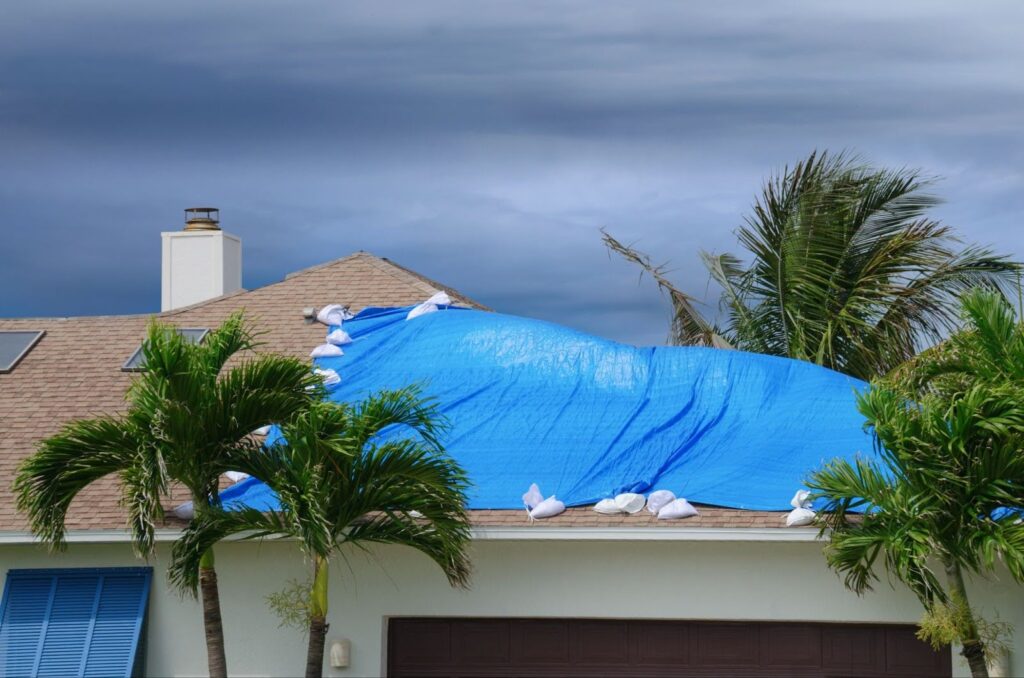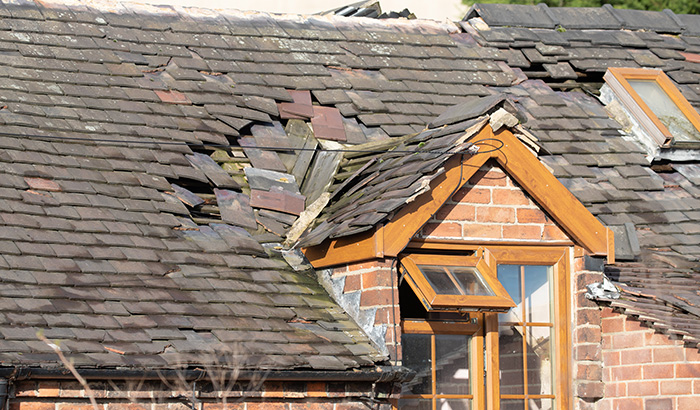Confronting storm damage might be overwhelming for homeowners. Storm damage takes many forms, including water damage and roof damage. Promptly addressing storm damage prevents further deterioration of your property. Quick action also makes filing an insurance claim easier.
This guide will walk you through five essential steps to take if your home has suffered storm damage: assessing immediate dangers, documenting the damage, protecting your home from further harm, contacting professional services for repair, and planning for future storms.
1. Safety first: Assess immediate dangers
When faced with storm damage, your priority should always be personal safety. Storms leave behind a variety of hazards. Before assessing the extent of the storm damage, ensure that it is safe to do so.
If you’re unsure about the safety of your home or the extent of the damage, it’s always best to consult with professionals who are able to safely evaluate and address the issues. Taking the following precautions will help you navigate the aftermath of storm damage safely.
Electrical hazards
One of the primary concerns after a storm is the risk of electrical hazards, especially if there’s water damage. Avoid entering areas of your home that are flooded, as water conducts electricity from damaged wires or electrical systems. If you suspect any electrical damage, turn off the power at the main breaker, but only if it’s safe to reach. If in doubt, call a professional to handle it.
Structural damage
Storms, particularly those with high winds, compromise the structural integrity of your home. Be wary of sagging roofs, cracks in walls, or any signs of structural weakening. If you notice significant structural damage, it’s best to evacuate the property and seek a professional assessment.
Gas leaks
Another potential danger is gas leaks. These happen when gas lines are damaged during a storm. If you smell gas or hear a hissing noise, immediately leave the area and contact your gas company. Do not use matches, lighters, or any electronic devices that could ignite the gas.
Water damage
Severe storms might cause water damage, which poses various risks. Be cautious of slippery surfaces, hidden debris in floodwaters, and weakened floors. Water damage often leads to mold growth, so address any wet areas as soon as it’s safe to do so.

2. Document damage for insurance claims
After securing your safety following storm damage, the next step is to document the damage thoroughly for insurance claims.
Effective documentation helps streamline the claims process and helps you receive the appropriate compensation for repairs. The more detailed and thorough your documentation, the smoother the insurance claims process will be.
Take photos and videos
Start by taking detailed photos and videos of all affected areas. Capture the extent of the storm damage from multiple angles. Include both wide shots and close-ups to show the details of the damage.
Pay special attention to areas that have suffered the most, as these are often the costliest to repair. If there is water damage, take pictures of water levels, if visible, and any water ingress in your home.
Make detailed lists
Alongside visual documentation, create a comprehensive list of all damaged property. Include the items’ descriptions, ages, and approximate cost, if possible. This list should cover everything from large pieces of furniture and electronics to smaller personal items affected by the storm damage. Be as thorough as possible and include even minor items.
Document structural damage
When documenting structural damage, such as roof damage, note any visible signs like missing shingles, leaks, or dents caused by hail or debris. If you suspect internal damage but are not able to safely assess it, make a note of this for your insurance provider, as a professional inspection may be necessary.
Keep records safe
Store your photos, videos, and lists in a safe and accessible place. Use digital storage options like cloud services to ensure your records are not lost if physical copies are damaged. Always backup your digital files, as well.
3. Protect your home from further damage
Once you have documented the storm damage, take immediate steps to prevent any further damage. Timely actions prevent additional issues and help in the overall recovery process.
While the solutions listed here are temporary solutions, they help prevent additional water and roof damage. These solutions also help maintain the integrity of your home until professional repairs are done. Remember, the quicker you act to secure your home, the better you mitigate the impacts of storm damage.
Water damage
If your home has suffered water damage or flooding, start by removing any standing water to prevent the spread of moisture. Use pumps or wet vacuums to remove standing water.
Elevate water-damaged furniture and remove wet carpets or rugs to aid in drying. Use fans and dehumidifiers to accelerate the drying process. If weather permits, open windows to allow air circulation.
Not all water damage is immediately visible or comes from flooding. Keep an eye out for the signs of water damage, even after all visible water has been removed.
Roof damage
For roof damage, use temporary solutions such as tarps to cover any holes or damaged areas until you get a full repair. You’ll want to keep water from entering the home and causing further damage. Secure the tarp with boards or heavy-duty tape to ensure it stays in place, especially if you expect more inclement weather.
Broken windows
Until they can be repaired, cover broken windows with plywood or heavy-duty plastic sheeting to prevent rain, wind, and debris from entering the home. Securely attach the coverings to withstand any potential subsequent storms.
Seal up leaks
If there are any leaks in your home, whether from the roof or through cracked walls, use sealants or waterproof tape to temporarily stop water ingress. This is a crucial step in mitigating water damage until permanent repairs are done.

4. Contact professional services for repair and restoration
After you’ve taken initial steps to protect your home, the next phase is repair and restoration. Choosing the right professionals for storm damage repair is vital to ensure your home is properly and safely restored.
You should choose your repair and restoration company carefully and thoughtfully. Expert services in water damage restoration and roof repair have the expertise to restore your home and protect it from future damage. The quality of repair work affects the immediate recovery of your home and its long-term resilience against storms.
Selecting the right professionals
Look for experienced and licensed contractors who specialize in storm damage repair. It’s important to choose a service that is well-versed in dealing with the specific types of damage your home has sustained, be it water damage, roof damage, or other structural issues.
Check for certifications, read reviews, and ask for references to gauge their reliability and quality of work. Look for companies that are insured and offer warranties on their repairs.
Services for water damage restoration
Water damage restoration is a complex process that requires a professional approach. It involves water extraction, drying, dehumidification, and sanitizing the affected areas.
Professionals will also assess for mold growth, which is a common problem following water damage. They have the necessary equipment and expertise to ensure your home is thoroughly dried and restored to prevent future mold and structural issues.
Roof repair services
Roof damage requires immediate attention to prevent further water damage to your home. Professional roofing contractors will assess the extent of the damage and determine whether repair or replacement is necessary. They address issues such as missing shingles, leaks, and structural damage caused by the storm.
5. Planning for future storms
Proactive measures reduce the impact of severe weather on your property. If you live in an area where storms are common, or if your house has had storm damage before, then it’s a good idea to prep your home in advance.
Regular maintenance and inspections
Conduct regular inspections of your home, particularly the roof, windows, and doors, to check that they are in good condition and are able to withstand harsh weather. Look for and repair any damage, such as loose shingles or seals, that could lead to water or roof damage during a storm. Don’t put off necessary repairs.
Reinforcing vulnerable areas
Identify areas of your home that are vulnerable to storm damage and take steps to reinforce them. This may include installing storm shutters, reinforcing garage doors, and ensuring proper drainage around your property to prevent water damage.
Emergency preparedness
Have an emergency kit ready with essential supplies and a plan in place for your family in case of severe storms. Knowing what to do and having the necessary supplies make a significant difference in your safety.
Call Utah Disaster Clean Up & Restoration to restore your home
Dealing with storm, water, or roof damage is often overwhelming. However, professional assistance makes the process easier.
At Utah Disaster Clean Up & Restoration, we specialize in providing expert storm damage restoration services. Our experienced team is equipped to handle all aspects of storm recovery, ensuring your home is safely and efficiently restored. We pride ourselves on offering quality work quickly so you can get back home sooner.
If you’re facing the challenges of storm damage, don’t hesitate to contact Utah Disaster Clean Up & Restoration for reliable and professional support.



